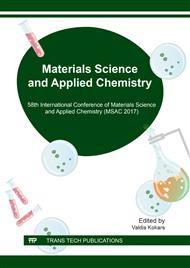[1]
Myers JP, Antoniou MN, Blumberg B, Carroll L, Colborn T, Everett LG, Hansen M, Landrigan FJ, Lanphear BP, Mesnage R, Vandenberg LN, vom Saal FS, Welshons WV, Benbrook CM. 2016. Concerns over use of glyphosate-based herbicides and risks associated with exposures: a consensus statement. Environ Health. 2016; 15: 19.
DOI: 10.1186/s12940-016-0117-0
Google Scholar
[2]
Glyphosate facts. Transparency on safety aspects and use of glyphosate-containing herbicides in Europe. Access: 20. 06. 2017. http: /www. glyphosate. eu/non-agricultural-uses-glyphosate.
DOI: 10.1533/9781845693183.8
Google Scholar
[3]
Popp, M., Hann S., Mentler A., Fuerhacker M., Stingeder G., Koellensperger G. 2008. Determination of glyphosate and AMPA in surface and waste water using high-performance ion chromatography coupled to inductively coupled plasma dynamic reaction cell mass spectrometry (HPIC–ICP–DRC–MS). Analytican and Bioanalytical Chemistry. Volume 391, Issue 2, pp.695-699.
DOI: 10.1007/s00216-008-2037-5
Google Scholar
[4]
Williams GM, Kroes R, Munro IC. 2000. Safety evaluation and risk assessment of the herbicide Roundup and its active ingredient, glyphosate, for humans. Regul Toxicol Pharmacol. 2000 Apr; 31(2 Pt 1): 117-65.
DOI: 10.1006/rtph.1999.1371
Google Scholar
[5]
Nakurte, I. 2016. Current trends and future perspective of glyphosate use, determination and control methods in Latvia. Workshop on pesticide fate in soil and water in the northern zone. Uppsala; Sweden; 7 September 2016 through 8 September (2016).
Google Scholar
[6]
Reno, U., Gutierrez, M.F., Longo, M., Vidal, E., Regaldo, L., Negro, A., Mariani, M., Zalazar, C., Gagneten, A.M. 2015. Microcrustaceans: Biological models to evaluate a remediation process of glyphosate-based formulations. Water, Air, and Soil PollutionVolume 226, Issue 10, 29 October 2015, Article number 349.
DOI: 10.1007/s11270-015-2616-y
Google Scholar
[7]
Amarante Jr., O. P.; Santos, T. C. R.; Brito, N. M.; Ribeiro, M. L. 2002. Glyphosate: properties, toxicity, use and legislation. Quim. Nova 25(4), 589-593.
Google Scholar
[8]
Rodriguez-Gil, J.L., Prosser, R., Hanta, G., Poirier, D., Lissemore, L., Hanson, M., Solomon, K.R. 2017a. Aquatic hazard assessment of MON 0818, a commercial mixture of alkylamine ethoxylates commonly used in glyphosate-containing herbicide formulations. Part 2: Roles of sediment, temperature, and capacity for recovery following a pulsed exposure. Environmental Toxicology and Chemistry 36(2), 512-521.
DOI: 10.1002/etc.3558
Google Scholar
[9]
Fiorilli, S., Rivoira, L., Calì, G., Appendini, M., Bruzzoniti, M.C., Coïssonc, M., Onidaa, B. 2017. Iron oxide inside SBA-15 modified with amino groups as reusable adsorbent for highly efficient removal of glyphosate from water. Applied Surface Science 411, 457-465.
DOI: 10.1016/j.apsusc.2017.03.206
Google Scholar
[10]
Xing, B., Chen, H., Zhang, X. 2017. Efficient degradation of organic phosphorus in glyphosate wastewater by catalytic wet oxidation using modified activated carbon as a catalyst. Environmental Technology (United Kingdom)13 April 2017, Pages 1-10.
DOI: 10.1080/09593330.2017.1310935
Google Scholar
[11]
Lan, H., He, W., Wang, A., Liu, R., Liu, H., Qu, J., Huang, C.P. 2016. An activated carbon fiber cathode for the degradation of glyphosate in aqueous solutions by the Electro-Fenton mode: Optimal operational conditions and the deposition of iron on cathode on electrode reusability. Water Research 105: 575: 582.
DOI: 10.1016/j.watres.2016.09.036
Google Scholar
[12]
Borisova, S.A., Christman, H.D., Metcalf, M.M., Zulkepli, N.A., Zhang, J.K., van der Donk, W.A., Metcalf, W.W., 2011. Genetic and biochemical characterization of a pathway for the degradation of 2-aminoethylphosphonate in Sinorhizobium meliloti 1021. J. Biol. Chem. 286, 22283-22290.
DOI: 10.1074/jbc.m111.237735
Google Scholar
[13]
McGrath, J.W., Chin, J.P., Quinn, J.P., 2013. Organophosphonates revealed: new insights into the microbial metabolism of ancient molecules. Nat. Rev. Microbiol. 11, 412-419.
DOI: 10.1038/nrmicro3011
Google Scholar
[14]
Wang, S., Seiwert, B., Kastner, M., Miltner, A., Schaffer, A., Reemtsma, T., Yang, Q., Nowak, K.M., 2016. (Bio)degradation of glyphosate in water-sediment microcosms a stable isotope co-labeling approach. Water Res. 99, 91-100.
DOI: 10.1016/j.watres.2016.04.041
Google Scholar
[15]
Grandcoin, A., Piel, S., Baurès, E. 2017. AminoMethylPhosphonic acid (AMPA) in natural waters: Its sources, behavior and environmental fate(Review). Water Research 117, 187-197.
DOI: 10.1016/j.watres.2017.03.055
Google Scholar
[16]
de Souza D.R., Trovó A.G., Filho N.R.A., Silva M.A.A., Machado A.E.H. 2013. Degradation of the commercial herbicide glyphosate by photo-fenton process: evaluation of kinetic parameters and toxicity. Journal of the Brazilian Chemical Society 24(9), 1451-1460.
DOI: 10.5935/0103-5053.20130185
Google Scholar
[17]
Muter O., Perkons I., Svinka V., Svinka R., Bartkevics V. 2017. Distinguishing the roles of carrier and biofilm in filtering media for the removal of pharmaceutical compounds from wastewater. Process Safety and Environmental Protection 111, 462-474.
DOI: 10.1016/j.psep.2017.08.010
Google Scholar
[18]
Muter, O., Versilovskis, A., Scherbaka, R., Grube, M., Zarina, Dz. 2008. Effect of plant extract on the degradation of nitroaromatic compounds by soil microorganisms. Journal of Industrial Microbiology and Biotechology 35, 1539-1543.
DOI: 10.1007/s10295-008-0455-1
Google Scholar
[19]
Rashidi H., GhaffarianHoseini A., GhaffarianHoseini A., Sulaiman N.M.N., Tookey J., Hashim N.A. Application of wastewater treatment in sustainable design of green built environments: A review. Renewable and Sustainable Energy Reviews. Renewable and Sustainable Energy Reviews 49 (2015).
DOI: 10.1016/j.rser.2015.04.104
Google Scholar
[20]
Wang Y, Chen X, Zhang J, Yin J, Wang H. Investigation of microfiltration for treatment of emulsified oily wastewater from the processing of petroleum products. Desalination 2009; 249: 1223-7.
DOI: 10.1016/j.desal.2009.06.033
Google Scholar
[21]
Zhang, M., Wei, Y., Zhao, K., Mei, R., Huang, M. 2011. Glyphosate degradation with industrial wastewater effluent by combined adsorption treatment and advanced oxidation processes. International Conference on Chemical Engineering and Advanced Materials, CEAM 2011; Changsha; China; 28 May 2011 through 30 May 2011; Code 84979, Advanced Materials Research 233-235, 369-372.
DOI: 10.4028/www.scientific.net/amr.233-235.369
Google Scholar
[22]
Alberdi, J.L., M.E. Saenz, W.D. Di Marzio, and M.C. Tortorelli. 1996. Comparative Acute Toxicity of Two Herbicides, Paraquat and Glyphosate, to Daphnia magna and D. spinulata. Bull. Environ. Contam. Toxicol. 57(2): 229-235.
DOI: 10.1007/s001289900180
Google Scholar
[23]
Le,T.H., E.S. Lim, S.K. Lee, Y.W. Choi, Y.H. Kim, and J. Min. 2010. Effects of Glyphosate and Methidathion on the Expression of the Dhb, Vtg, Arnt, CYP4 and CYP314 in Daphnia magna. Chemosphere 79(1): 67-71. Hansen, L.R., Roslev, P. 2016. Behavioral responses of juvenile Daphnia magna after exposure to glyphosate and glyphosate-copper complexes. Aquatic Toxicology 179, 36-43.
DOI: 10.1016/j.chemosphere.2009.12.067
Google Scholar
[24]
Hansen, L.R., Roslev, P. 2016. Behavioral responses of juvenile Daphnia magna after exposure to glyphosate and glyphosate-copper complexes. Aquatic Toxicology 179, 36-43.
DOI: 10.1016/j.aquatox.2016.08.010
Google Scholar


